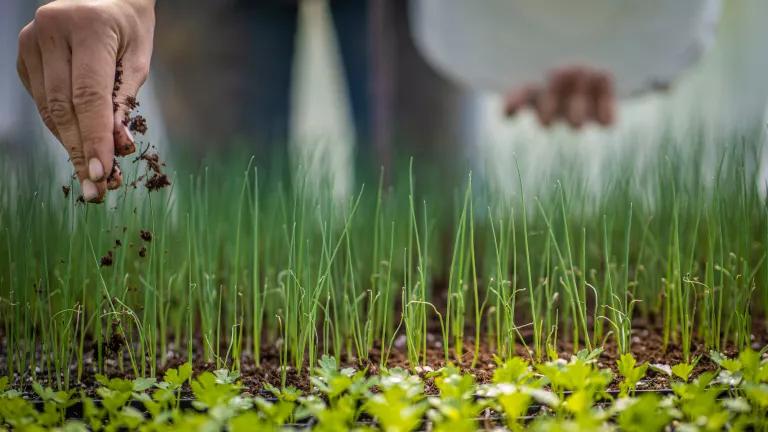The Food System Is Critical Infrastructure
We need to invest in rebuilding the food system from the bottom up as critical infrastructure for a just and sustainable future.

Owner Valerie Chim picking guma and other West Indies vegetables at Flamingo Farms in Davie, Florida, on February 23, 2021.
Congress is considering two massive investments in America’s infrastructure: the American Jobs Plan, focused on physical infrastructure and jobs, and the American Families Plan, focused on human infrastructure and care. The two plans are critical to the Biden administration’s promise to “build back better,” and they take aim at the intersecting challenges of economic prosperity, public health, racial justice, and the climate crisis. However, as we work to address the biggest challenges of our day, we must not forget the urgent need to transform the food system.
Federal investment in food and agriculture can create jobs, fuel the economy, support families, advance justice, and address climate change. Furthermore, food offers a powerful opportunity to connect the two plans, reinforcing the relationship between farmers and communities that our siloed policy structure too often misses.
NRDC has joined with the National Sustainable Agriculture Coalition and 450 other groups to call for a $200 billion investment in sustainable and equitable food over the next ten years. Drawing on initiatives included in the Agriculture Resilience Act and Climate Stewardship Act, this funding would cover broad ground, including support for conservation programs and renewable energy, and critical infrastructure to improve regional food system and supply chain resilience.
Public Investment for the Public Good
Our current food system does not work for most farmers, consumers, or those in between. It is designed to benefit the large corporate agribusinesses that extract profit at every stage of the food chain and trap everyone else in an unacceptable status quo. Current federal policy incentivizes the use of fossil fuel-based pesticides, risky monocropping, industrial meat production, and other practices that poison our air and water, emit greenhouse gases, and reduce the soil’s natural ability to pull carbon from the atmosphere. U.S. taxpayers subsidize companies that fail to protect the health, safety, and rights of a largely immigrant workforce, and underwrite a food system that fails to provide all communities with affordable, accessible, and culturally appropriate food. Building back better offers an opportunity to shift this dynamic by rebuilding our food infrastructure from the ground up to promote health, advance equity, address climate change, and increase resilience.
Food, Jobs, and Care
One in six American jobs is in the food system, so improving the food system is a critical component of building a just economy. Yet as proposed, the American Jobs Plan does not invest enough in food and agriculture. This oversight is surprising, especially since the pandemic highlighted so many problems in the food system, from farmers plowing under fields and mass animal depopulations when producers lost access to markets, to the death of nearly 400 workers as slaughterhouses became COVID-19 hotspots, to miles long lines at food banks across the country. It’s also a missed opportunity, given the important role that food and agriculture play as both a greenhouse gas emitter and potential climate solution.
The American Families Plan does better. It includes important investments in federal nutrition programs that would expand free school meals and ensure that children have access to food during the summer months. But it too could, and should, do even more, for example by making universal free school meals permanent and significantly expanding both access to SNAP and the dollar value of SNAP benefits. These improvements would strengthen the safety net, reduce hunger, and promote health—and provide the security and peace of mind that families can use to focus on other aspects of care.
An Integrated Food Agenda
Even more powerfully, food offers an opportunity to link the two packages, building connections between farmers and consumers and between rural and urban communities. In doing so, we can tackle the intersection of climate, care, and the economy, and maximize the impact of these investments as a win-win-win for farmers, families, and the planet. An integrated agenda can prioritize justice by targeting resources and outreach to Black, Indigenous, Latinx, Asian, and other farmers and communities of color.
Examples of how Congress could make this connection include:
- Expand farm to school programs, so that as we increase access to school and summer meals, we simultaneously build markets for local and regional healthy and climate-friendly producers, while bringing more fresh fruits and vegetables to students.
- Build regional food infrastructure, through investments in regional slaughterhouses, processing facilities, food hubs, and farmers markets that would provide alternatives to conventional processing and distribution for small- and mid-size farmers and ranchers, better connect regional supply and demand, support local food economies, and create jobs.
- Leverage SNAP benefits, by expanding Double Up Food Bucks and other incentive programs to make local and organic fruits and vegetables more affordable at farmers markets and food stores, and by investing in technology so small-scale producers can participate in online SNAP purchasing.
- Expand composting to reduce the amount of organic waste that ends up in landfills or incinerators, and ensure a steady, low-cost supply of compost to local farmers and community gardens, all the while supporting regenerative farming practices and improving soil health.
Win-Win-Win Solutions
These investments are wins for farmers, families, and the climate. The COVID-19 relief bills already enacted have included important aid for both farmers and families facing hunger, but there is much more to be done. The newly proposed infrastructure packages offer an opportunity to leverage the importance of the food system as a force for national change—allowing Congress to improve the lives of all Americans.


